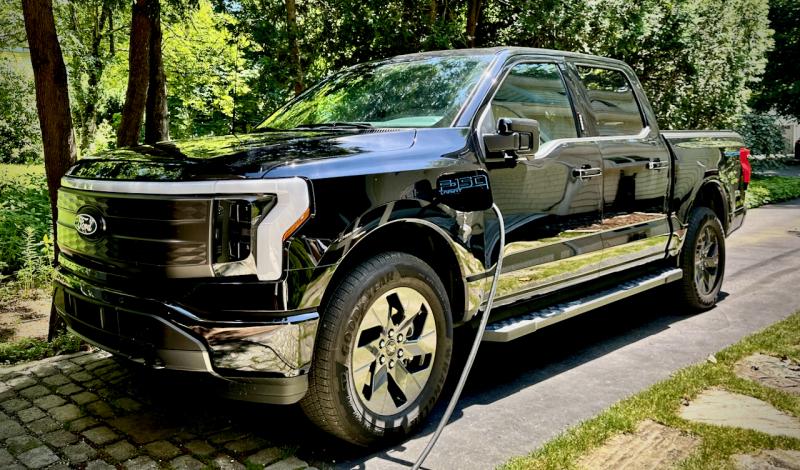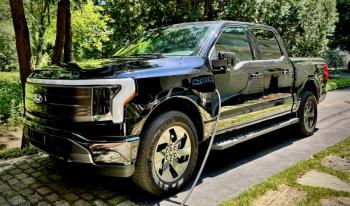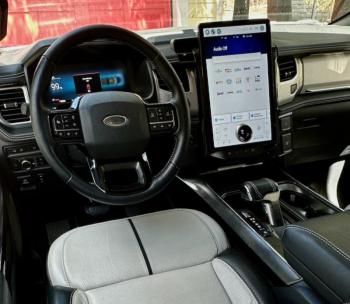Still Striking: Ford F-150 Lightning
 The most significant ‘upgrade’ to the battery-powered Lightning for 2025 is a drop in price. All Lightnings are full-size, four-door crew-cab F-150s with 51/2-foot beds, extra storage space in the ‘frunk,’ and up to 320 miles of range, with 10,000 pounds of trailer capacity available, although the range drops precipitously when towing. This color is Agate Black Metallic.
The most significant ‘upgrade’ to the battery-powered Lightning for 2025 is a drop in price. All Lightnings are full-size, four-door crew-cab F-150s with 51/2-foot beds, extra storage space in the ‘frunk,’ and up to 320 miles of range, with 10,000 pounds of trailer capacity available, although the range drops precipitously when towing. This color is Agate Black Metallic.
 The 151/2-inch touchscreen is one of the Lariat’s prime features. Loaded with apps including BlueCruise, onboard navigation, wireless Apple CarPlay and Android Auto as well as Ford’s Sync 4 software, it is easy to read and easy to use. The Lariat trim also includes an eight-speaker Bang & Olufson stereo.
The 151/2-inch touchscreen is one of the Lariat’s prime features. Loaded with apps including BlueCruise, onboard navigation, wireless Apple CarPlay and Android Auto as well as Ford’s Sync 4 software, it is easy to read and easy to use. The Lariat trim also includes an eight-speaker Bang & Olufson stereo.
 The most significant ‘upgrade’ to the battery-powered Lightning for 2025 is a drop in price. All Lightnings are full-size, four-door crew-cab F-150s with 51/2-foot beds, extra storage space in the ‘frunk,’ and up to 320 miles of range, with 10,000 pounds of trailer capacity available, although the range drops precipitously when towing. This color is Agate Black Metallic.
The most significant ‘upgrade’ to the battery-powered Lightning for 2025 is a drop in price. All Lightnings are full-size, four-door crew-cab F-150s with 51/2-foot beds, extra storage space in the ‘frunk,’ and up to 320 miles of range, with 10,000 pounds of trailer capacity available, although the range drops precipitously when towing. This color is Agate Black Metallic.
 The 151/2-inch touchscreen is one of the Lariat’s prime features. Loaded with apps including BlueCruise, onboard navigation, wireless Apple CarPlay and Android Auto as well as Ford’s Sync 4 software, it is easy to read and easy to use. The Lariat trim also includes an eight-speaker Bang & Olufson stereo.
The 151/2-inch touchscreen is one of the Lariat’s prime features. Loaded with apps including BlueCruise, onboard navigation, wireless Apple CarPlay and Android Auto as well as Ford’s Sync 4 software, it is easy to read and easy to use. The Lariat trim also includes an eight-speaker Bang & Olufson stereo.
About the Lightning, I wrote, in May of 2023: “Shock and amazement, but the new vehicle I was most interested in driving this year is not an AMG Mercedes or a mid-engine Corvette, but a pickup truck—this one, the electric F-150 Lightning from Ford.” And I wondered whether mainstream pickup-truck buyers would go for something “so futuristic and green.”
The world has wobbled on its axis since then. The Far Right has declared electric vehicles evil; a new President has promised to kill subsidies for them and funding for recharging stations; and carmakers have fallen all over themselves to pivot away from EVs and assure us that the internal-combustion engine is here to stay.
Politics aside, however, what happened with EVs mirrors many trends, which begin with wild enthusiasm, cool off as reality intrudes, then settle down to some level of normalcy. EVs don’t suit everyone and every sort of driving; electricity isn’t free or even necessarily “clean”; and did anyone really think gas and diesel engines would disappear?
Peek behind the curtain and we find that, while Elon Musk’s machinations have hurt Tesla overall, other EVs are selling pretty well, if not at the unsustainable fever pitch of 2023, when sales shot up by 49%. Last year EVs made up 8.7% of new cars sold in the US and are projected to reach 10% this year. These aren’t just foreign brands, either: in the first quarter of this year, General Motors sold 31,887 EVs, almost twice as many as in the same interval as last year.
Sales of the Ford Lightning, which debuted to much fanfare way back in 2021, have seesawed up and down. Ford ran into manufacturing snags, including shortages of electronic components, and then—once the novelty began to fade—price resistance. But the Lightning is still a technological marvel. It still drives very well. And competition (mainly from Rivian and the Cybertruck) as well as natural selection have enabled, or forced, Ford to develop a more realistic mix of trim and price levels.
For 2025, the Lightning lineup includes a fleet-sales model called the Pro, with a starting MSRP of $49,975, followed by the XLT at $65,190, the Flash ($70,190), the Lariat ($79,190) and the Platinum, which starts at $87,190. All have two motors and AWD, four-door crew cabs and 51/2-foot beds, and various options are available. We’re driving a Lariat with a sticker price of $86,785, which includes almost $8,000 worth of add-ons in addition to destination & delivery fees. It’s a 2024 model, though, and this year the starting price of the Lariat is almost three grand less.
But the big picture hasn’t changed. With the extended-range, 131-kilowatt-hour battery pack, the Lariat is still rated for a whopping 580 horsepower and a 775 pound-feet of torque with a projected range of 320 miles. On a public supercharger, such as a Tesla station, going from 15% charge to 80% should take just over 40 minutes. A full top-up on a Level II home charger takes as little as eight hours with Ford’s 80-amp Charge Station Pro system, which comes with the extended-range battery.
One of our Lariat’s options is the Max Trailer Tow Package ($1,100), which boosts the towing capacity to 10,000 pounds, but this sort of load reportedly cuts the range to as little as 100 miles. More useful is the $2,100 BlueCruise self-driving option. On highways with Internet coverage, BlueCruise does an excellent job of keeping the truck in its lane even in heavy traffic. The driver still has to pay attention, though: when a smear in a freshly painted lane markings led to the side of Rte. 295, the truck swerved to follow. Unnerving.
Otherwise, the Lariat’s safety, driver-assistance, comfort and convenience features rival those of many plush sedans and SUVs, although some of the materials are less than deluxe.
The Lightning Lariat fulfills its truck mandate well, so long as that doesn’t include towing even moderate loads, except perhaps around town. As a work vehicle, it’s rated to carry a ton (1,913 pounds, to be precise) of people, tools and supplies from job site to job site and then, with the Pro Power Onboard package, provide juice for radial saws and other electric devices. Famously, the Lightning can also power a suitably wired home for up to three days in a power outage.
As a daily driver, the high-riding, high-output Lariat is more than satisfying. Although it weighs nearly two and a half tons, all that power and a relatively low center of gravity plus independent rear suspension and accurate, if numb, steering make the truck unexpectedly nimble. It’s comfortable too, and the absence of engine noise feels luxurious. Finally, it’s impossible not to like 580 horses and 775 torques. The acceleration is, shall we say, lightning-quick and, off the line, the Lightning can pose a serious threat to any number of high-dollar, high-snoot sports cars.
Next week: Kia K4


























